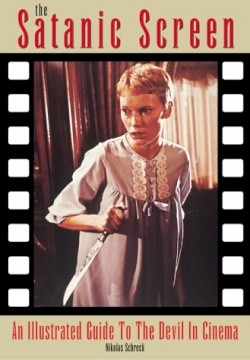The Satanic Screen
An Illustrated History of the Devil in Cinema 1896-1999
“What have you done to his eyes?” asks a young mother, falling to the heels of the Satanist coven that encircles her as she peers into a cradle spun with black crepe. “He has his father’s eyes,” is the reply. With Roman Polanski’s film Rosemary’s Baby comes a conjuring of emotion: self-doubt, paranoia, and fear—a cinematic séance for the devil.
Incarnating the seventeenth edition in a guerrilla series of film studies (which pans from the magnetic morbidity of the snuff film, to the riotous filth-chic of John Waters movies), Satanic Screen documents the manifestation of the devil in cinema. The author, a widely accepted occultist authority, lends credibility and a palpable enthusiasm to the release, boasting both sound scholarly approach and aficionado’s flair.
Dancing in the shafts of light thrown from seventeenth-century “magic lanterns,” Schreck asserts, were the seeds of satanic cinema. These primitive devices cast flitting illusions of demons above the shifting eyes of the mesmerized and the averted eyes of the fearful. Schreck commands an admirably discerning focus upon these obscure origins of the genre, which include the nascent German film industry, nourished by its rich heritage of gothic and romantic influence. He wastes few words on ready-to-eat modern efforts—“as I’m convinced that the homogenized sterility of the 1980s and 1990s culture marked a dismal nadir.”
Each chapter is devoted to a decade of satanic film, conveying a sense of momentum as the reader monitors the growth of celluloid sinews and the barometer of social response to their impious strides. Paying close attention to the presence of occultists and the Black Arts, the book is driven to sociological as well as aesthetic ends. Schreck notes, for example, that “Rosemary’s Baby became a blue print for the occult renaissance of the late 1960s.” Brutally honest appraisals invite both levity and critical thinking, as merit is divorced from film budget and popularity. Regarding The Exorcist (1973), Schreck writes: “One of the most culturally resonant—although artistically uninteresting—films in Satanic cinema history, this Judeo-Christian demonization of female sexuality brings us right back to the middle ages.”
Ample production stills, posters, and illustrations garnish the text, which is most readily aimed at film students or those with occultist interest, though the appeal to audiences expands with solid sociological shadings. Straying beyond the safety of mainstream features, Satanic Screen deftly walks the cloven path of the devil in film.
Disclosure: This article is not an endorsement, but a review. The publisher of this book provided free copies of the book to have their book reviewed by a professional reviewer. No fee was paid by the publisher for this review. Foreword Reviews only recommends books that we love. Foreword Magazine, Inc. is disclosing this in accordance with the Federal Trade Commission’s 16 CFR, Part 255.

